|
GRE Quantitative Reasoning Practice Test 1
Section 1 20 questions Total time for this section: 35 Minutes You can use a basic calculator on this section.
|
| 1- |
\(a\) and \(b\) are real numbers. \(a<b\)
| Quantity A |
Quantity B |
| \(|a\ -\ b|\) |
\(|b\ -\ | \) |
|
| (A) |
Quantity A is greater. |
| (B) |
Quantity B is greater. |
| (C) |
The two quantities are equal. |
| (D) |
The relationship cannot be determined from the information given. |
| 2- |
\(6\) percent of \(x\) is equal to \(5\) percent of \(y\), where \(x\) and \(y\) are positive numbers.
| Quantity A |
Quantity B |
| \(x\) |
\(y \) |
|
| (A) |
Quantity A is greater. |
| (B) |
Quantity B is greater. |
| (C) |
The two quantities are equal. |
| (D) |
The relationship cannot be determined from the information given. |
| 3- |
\(x\) is an integer greater than zero.
| Quantity A |
Quantity B |
| \(\frac{ 1}{x}\ +\ x \) |
\(8 \) |
|
| (A) |
Quantity A is greater. |
| (B) |
Quantity B is greater. |
| (C) |
The two quantities are equal. |
| (D) |
The relationship cannot be determined from the information given. |
| 4- |
| Quantity A |
Quantity B |
| The least prime factor of \(55\) |
The least prime factor of \(210 \) |
|
| (A) |
Quantity A is greater. |
| (B) |
Quantity B is greater. |
| (C) |
The two quantities are equal. |
| (D) |
The relationship cannot be determined from the information given. |
| 5- |
Emma and Sophia have a family business. The profit of their business will be divided between Emma and Sophia in the ratio \(3\) to \(4\) respectively.;
| Quantity A |
Quantity B |
| The money Emma receives when the profit is \($560\). |
The money Sophia receives when the profit is \($420\). |
|
| (A) |
Quantity A is greater. |
| (B) |
Quantity B is greater. |
| (C) |
The two quantities are equal. |
| (D) |
The relationship cannot be determined from the information given. |
| 6- |
The volume of a sphere with diameter of length 5 is how many times the volume of sphere with diameter of length \(\sqrt{5}\) ?
(Volume of a sphere\( =\frac{ 4}{3} \ π\ r^3)\) . |
| (A) |
\(\sqrt{5}\) |
| (B) |
\({5}\) |
| (C) |
\(10\) |
| (D) |
\(10\sqrt{5}\) |
| (E) |
\(5\sqrt{5}\) |
| 7- |
What is the solution of the following system of equations?
\(\begin{cases}-\ \frac{x}{2}\ +\ \frac{y}{4}=1\\ -\ \frac{5\ y} {6}\ +\ 2\ x=4\end{cases}\) |
| (A) |
\(x=48, \ y=22\) |
| (B) |
\(x=50, \ y=20\) |
| (C) |
\(x=20, \ y=50\) |
| (D) |
\(x=22, \ y=48\) |
| (E) |
\(x=22, \ y=50\) |
| 8- |
If \(y=2^4\) then what is the value of \( y^\sqrt{y}\)? |
| (A) |
\(2\) |
| (B) |
\(2^4\) |
| (C) |
\(2^8\) |
| (D) |
\(2^{16}\) |
| (E) |
\(2^{32}\) |
| 9- |
The average weight of \(18\) girls in a class is \(60\) kg and the average weight of \(32\) boys in the same class is \(62\) kg. What is the average weight of all the \(50\) students in that class? |
| (A) |
\(60\) |
| (B) |
\(61.28\) |
| (C) |
\(61.68\) |
| (D) |
\(61.90\) |
| (E) |
\(62.20\) |
| 10- |
If \(60 \%\) of A is \(20 \%\) of B, then B is what percent of A? |
| (A) |
\(3\%\) |
| (B) |
\(30\%\) |
| (C) |
\(200\%\) |
| (D) |
\(300\%\) |
| (E) |
\(900\%\) |
| 11- |
If \((x\ -\ 2)^3=27\) which of the following could be the value of \((x\ -\ 4)\ (x\ -\ 3)\)? |
| (A) |
\(1\) |
| (B) |
\(2\) |
| (C) |
\(6\) |
| (D) |
\(-\ 1 \) |
| (E) |
\(-\ 2 \) |
| 12- |
The average of \( x , y\) and \(5\) is \(5\) and \(x\ -\ y=-\ 8\) What is the value of \(x\ ×\ y\) ? |
| (A) |
\(9 \) |
| (B) |
\(- \ 9 \) |
| (C) |
\(- \ 8 \) |
| (D) |
\( 8 \) |
| (E) |
\( 0 \) |
| 13- |
The surface area of a cylinder is \(150\ π\) cm\(^2\). If its height is \(10\) cm, what is the radius of the cylinder? |
| (A) |
\( 13 \) cm |
| (B) |
\( 11 \) cm |
| (C) |
\( 15 \) cm |
| (D) |
\( 5 \) cm |
| (E) |
\( 7 \) cm |
| 14- |
In the \(xy\)-plane, the point \((4,3)\) and \((3,2)\) are on line A. Which of the following equations of lines is parallel to line A? |
| (A) |
\( y= 3\ x\) |
| (B) |
\( y= 10\) |
| (C) |
\( y= \frac{x}{2}\) |
| (D) |
\( y=2\ x \) |
| (E) |
\( y=x \) |
| 15- |
What is the product of the number of Mathematics and number of English books?
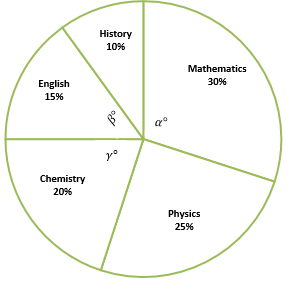 |
| (A) |
\( 21,168 \) |
| (B) |
\( 31,752 \) |
| (C) |
\( 26,460 \) |
| (D) |
\( 17,640 \) |
| (E) |
\( 14,112 \) |
| 16- |
What are the values of angle \(α\) and \(β\) ?
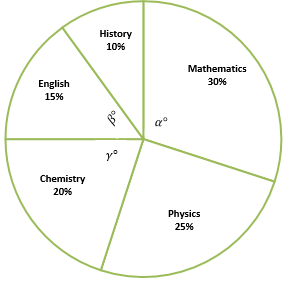 |
| (A) |
\( 90^ \circ , 54^\circ \) |
| (B) |
\( 120^ \circ , 36^\circ \) |
| (C) |
\( 120^ \circ , 45^\circ \) |
| (D) |
\( 108^ \circ , 54^\circ \) |
| (E) |
\( 108^ \circ , 36^\circ \) |
| 17- |
The librarians decided to move some of the books in the Mathematics section to Chemistry section. How many books are in the Chemistry section if now \(γ=\frac{2}{5}\ α\)?
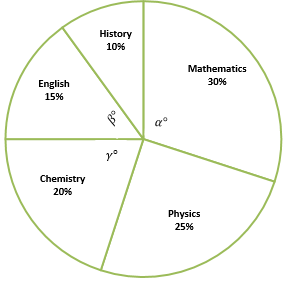 |
| (A) |
\(80\) |
| (B) |
\(120\) |
| (C) |
\(150\) |
| (D) |
\(180\) |
| (E) |
\(200\) |
| 18- |
Let \(r\) and p be constants. If \(x^2\ +\ 6\ x\ +\ r\) factors into \( (x \ +\ 2)\ (x \ +\ p)\), the values of \(r\) and \(p\) respectively are? |
| (A) |
\(8, 4 \) |
| (B) |
\(4, 8 \) |
| (C) |
\(6, 3 \) |
| (D) |
\(3, 6 \) |
| (E) |
The answer cannot be found from the information given. |
| 19- |
In how many ways can \(5\) cards be placed in \(3\) positions if any cards can be placed in any position? |
| (A) |
\(5\) |
| (B) |
\(10\) |
| (C) |
\(15\) |
| (D) |
\(30\) |
| (E) |
\(120\) |
| 20- |
If \((x\ -\ 2)^2\ +\ 1\ >\ 3\ x\ -\ 1\), then \(x\) can equal to which of the following? |
| (A) |
\(1\) |
| (B) |
\(6\) |
| (C) |
\(8\) |
| (D) |
\(3\) |
| (E) |
\(4\) |
|
GRE Quantitative Reasoning Practice Test 1
Section 2 20 questions Total time for this section: 35 Minutes You can use a basic calculator on this section.
|
| 21- |
| Quantity A |
Quantity B |
| \( (-\ 5)^4\) |
\( 5^4\) |
|
| (A) |
Quantity A is greater. |
| (B) |
Quantity B is greater. |
| (C) |
The two quantities are equal. |
| (D) |
The relationship cannot be determined from the information given. |
| 22- |
The average of \(3, 4\), and \(x\) is \(3\).
| Quantity A |
Quantity B |
| \( x\) |
average of \(x,\ x\ -\ 6,\ x\ +\ 4,\ 2\ x\) |
|
| (A) |
Quantity A is greater. |
| (B) |
Quantity B is greater. |
| (C) |
The two quantities are equal. |
| (D) |
The relationship cannot be determined from the information given. |
| 23- |
\(\frac{4}{5}<\ x\ <\frac{6}{7}\)
| Quantity A |
Quantity B |
| \( x\) |
\(\frac{5}{6}\) |
|
| (A) |
Quantity A is greater. |
| (B) |
Quantity B is greater. |
| (C) |
The two quantities are equal. |
| (D) |
The relationship cannot be determined from the information given. |
| 24- |
\(n\) is a natural number and \(\frac{1}{3^n} <\frac{1}{27}\)
| Quantity A |
Quantity B |
| \( 3\) |
\(n\) |
|
| (A) |
Quantity A is greater. |
| (B) |
Quantity B is greater. |
| (C) |
The two quantities are equal. |
| (D) |
The relationship cannot be determined from the information given. |
| 25- |
| Quantity A |
Quantity B |
| \( \frac{ x^6}{6}\) |
\((\frac{x}{6})^6\) |
|
| (A) |
Quantity A is greater. |
| (B) |
Quantity B is greater. |
| (C) |
The two quantities are equal. |
| (D) |
The relationship cannot be determined from the information given. |
| 26- |
| Quantity A |
Quantity B |
| \(5\ +\ 8\ ×\ (–\ 2)\ –\ [4\ +\ 22\ ×\ 5]\ ÷\ 6 \) |
\([6\ ×\ (–\ 24)\ +\ 8]\ –\ (–\ 4)\ +\ [4\ ×\ 5]\ ÷\ 2 \) |
|
| (A) |
Quantity A is greater. |
| (B) |
Quantity B is greater. |
| (C) |
The two quantities are equal. |
| (D) |
The relationship cannot be determined from the information given. |
| 27- |
If \(|a|<1\), then which of the following is true? \((b>0)\)?
I. \(–\ b<b\ a <b\)
II.\(-\ a<a^2<a\) if \(a<0\)
III.\(-\ 5<2\ a\ -\ 3<-\ 1\) |
| (A) |
I only |
| (B) |
II only |
| (C) |
I and III only |
| (D) |
III only |
| (E) |
I, II and III |
| 28- |
The ratio of boys and girls in a class is \(4:7\). If there are \(44\) students in the class, how many more boys should be enrolled to make the ratio \(1:1\)? |
| (A) |
\(8\) |
| (B) |
\(10\) |
| (C) |
\(12\) |
| (D) |
\(14\) |
| (E) |
\(28\) |
| 29- |
If \(150 \%\) of a number is \(75\), then what is \(90 \%\) of that number? |
| (A) |
\(45\) |
| (B) |
\(50\) |
| (C) |
\(70\) |
| (D) |
\(85\) |
| (E) |
\(90\) |
| 30- |
Removing which of the following numbers will change the average of the numbers to \(6\)?
\(1, \ 4, \ 5, \ 8, \ 11, \ 12\) |
| (A) |
\(1\) |
| (B) |
\(4\) |
| (C) |
\(5\) |
| (D) |
\(11\) |
| (E) |
\(12\) |
| 31- |
The length of a rectangle is \(\frac{5}{4}\) times its width. If the width is \(16\), what is the perimeter of this rectangle? |
| (A) |
\(36\) |
| (B) |
\(48\) |
| (C) |
\(72\) |
| (D) |
\(144\) |
| (E) |
\(180\) |
| 32- |
The marked price of a computer is D dollar. Its price decreased by \(20\%\) in January and later increased by \(10 \%\) in February. What is the final price of the computer in D dollar? |
| (A) |
\(0.80\) D |
| (B) |
\(0.88\) D |
| (C) |
\(0.90\) D |
| (D) |
\(1.20\) D |
| (E) |
\(1.40\) D |
| 33- |
In the following figure, what is the perimeter of \(∆ ABC\) if the area of \(∆ ADC\) is \(15\)?
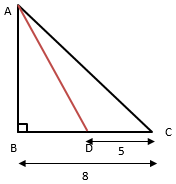 |
| (A) |
\(37.5\) |
| (B) |
\(21\) |
| (C) |
\(15\) |
| (D) |
\(24\) |
| (E) |
The answer cannot be determined from the information given |
| 34- |
A line \(l\) is parallel to the \(x\)-axis and passes through the point \((-3,4)\). What is the slope of the line \((m)\) and its \(y\)-intercept? |
| (A) |
\(𝑚=∞, y\ −\) intercept \(=4\) |
| (B) |
\(𝑚=∞, y\ −\) intercept \(=-\ 3\) |
| (C) |
\(𝑚=0, y\ −\) intercept \(=-\ 3\) |
| (D) |
\(𝑚=0, y\ −\) intercept \(=4\) |
| (E) |
\(𝑚=-\ 3, y\ −\) intercept \(=4\) |
| 35- |
Between which two of the months shown was there a twenty percent decreased in the number of pants sold?
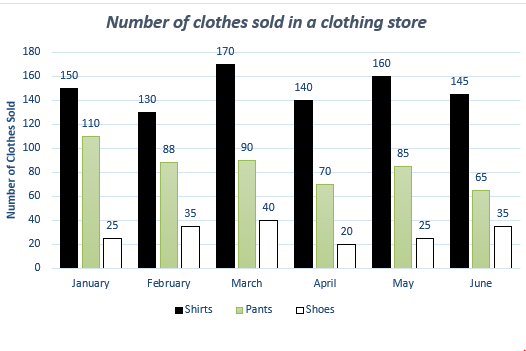 |
| (A) |
January and February |
| (B) |
February and March |
| (C) |
March and April |
| (D) |
April and May |
| (E) |
May and June |
| 36- |
During the six-month period shown, what is the median number of shirts and mean number of shoes per month?
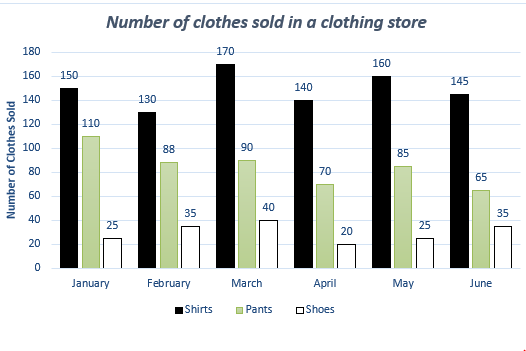 |
| (A) |
\(146.5, 30\) |
| (B) |
\(147.5, 29\) |
| (C) |
\(146.5, 31\) |
| (D) |
\(147.5, 30\) |
| (E) |
\(146.5, 29\) |
| 37- |
How many shoes need to be added in April until the ratio of number of pants to number of shoes in April equals to five-seventeenth of this ratio in May?
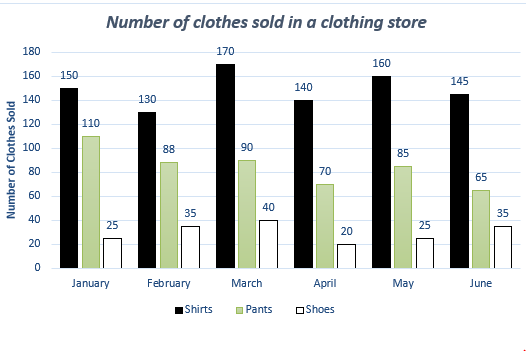 |
| (A) |
\(90\) |
| (B) |
\(80\) |
| (C) |
\(70\) |
| (D) |
\(60\) |
| (E) |
\(50\) |
| 38- |
What is the product of all possible values of \(x\) in the following equation? \(|x\ -\ 2\ x\ -\ 5\ +\ 7|=4\) |
| (A) |
\(12\) |
| (B) |
\(-\ 12\) |
| (C) |
\(6\) |
| (D) |
\(-\ 6\) |
| (E) |
\(0\) |
| 39- |
In the following figure, ABCD is a rectangle, and E and F are points on AD and DC, respectively and DE\(=4\) and DF\(=3\). The area of ∆BED is \(16\), and the area of ∆BDF is \(18\). What is the perimeter of the rectangle?
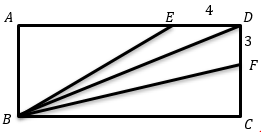 |
| (A) |
\(20\) |
| (B) |
\(22\) |
| (C) |
\(32\) |
| (D) |
\(40\) |
| (E) |
\(44\) |
| 40- |
In the following figure, ABCD is a rectangle. If a\(=\sqrt{3}\), and b\(=2\ a\), find the area of the shaded region. (the shaded region is a trapezoid)
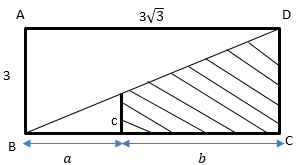 |
| (A) |
\(4\) |
| (B) |
\(2\) |
| (C) |
\(\sqrt{3}\) |
| (D) |
\(2\sqrt{3}\) |
| (E) |
\(4\sqrt{3}\) |